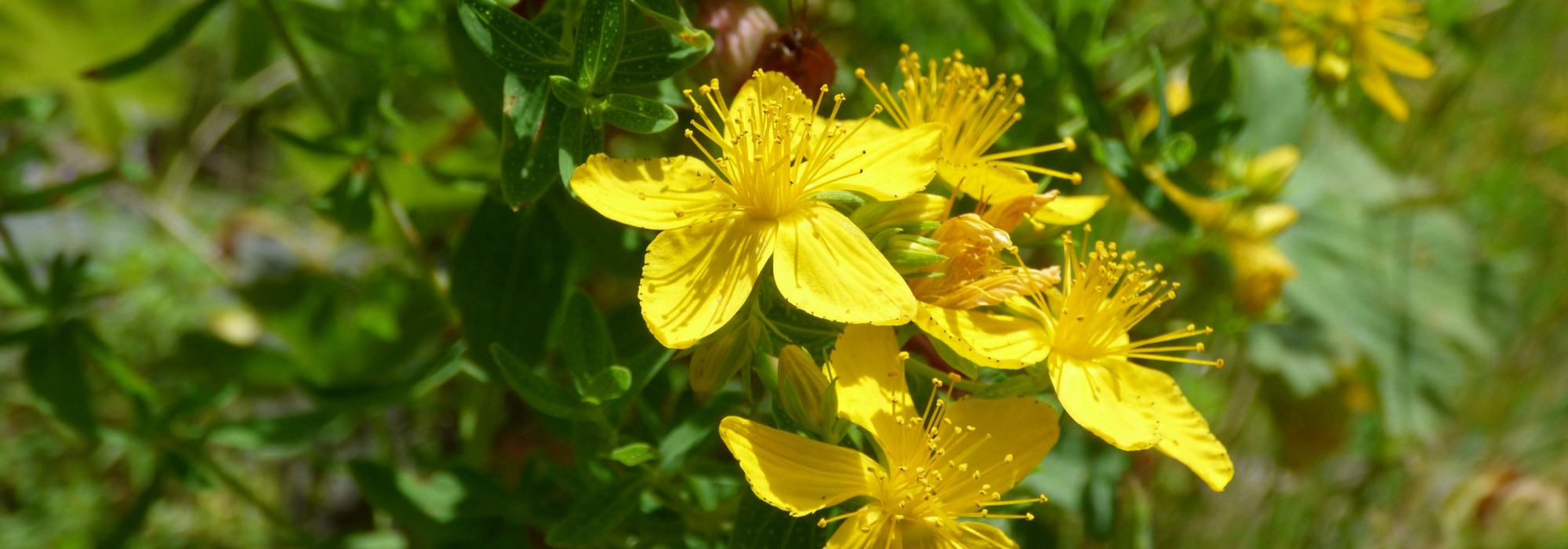
Hypericum, St John's wort: planting, pruning, maintenance
Contents
Hypericum, in a nutshell
- St. John’s Worts are very easy-going bushes, hardy, robust, and fast-growing, ideal for filling neglected spaces
- They charm with their long bright yellow flowering, enhanced by a large bouquet of stamens, as well as their dense, well-provided foliage
- Their habit ranges from ground cover to vigorous bushy shrub
- Their uses are multiple, ranging from slopes to border plantings or rockeries, to refined terraces
- The dense and healthy foliage, whether evergreen or deciduous, is highly variable in both shape and colour
- In some species like inodorum, the colourful berries accompany the flowering
A word from our expert
The St. John’s Worts, well known as Hypericum, are small bushes that are very popular in our gardens due to their incredible ease of cultivation. From the ground cover Hypericum calycinum, formidable against weeds, to the timeless Hypericum ‘Hidcote’ from our grandmothers’ gardens, to the delightful orange flowering of Hypericum x inodorum ‘Excellent Flair’, these bushes are almost foolproof.
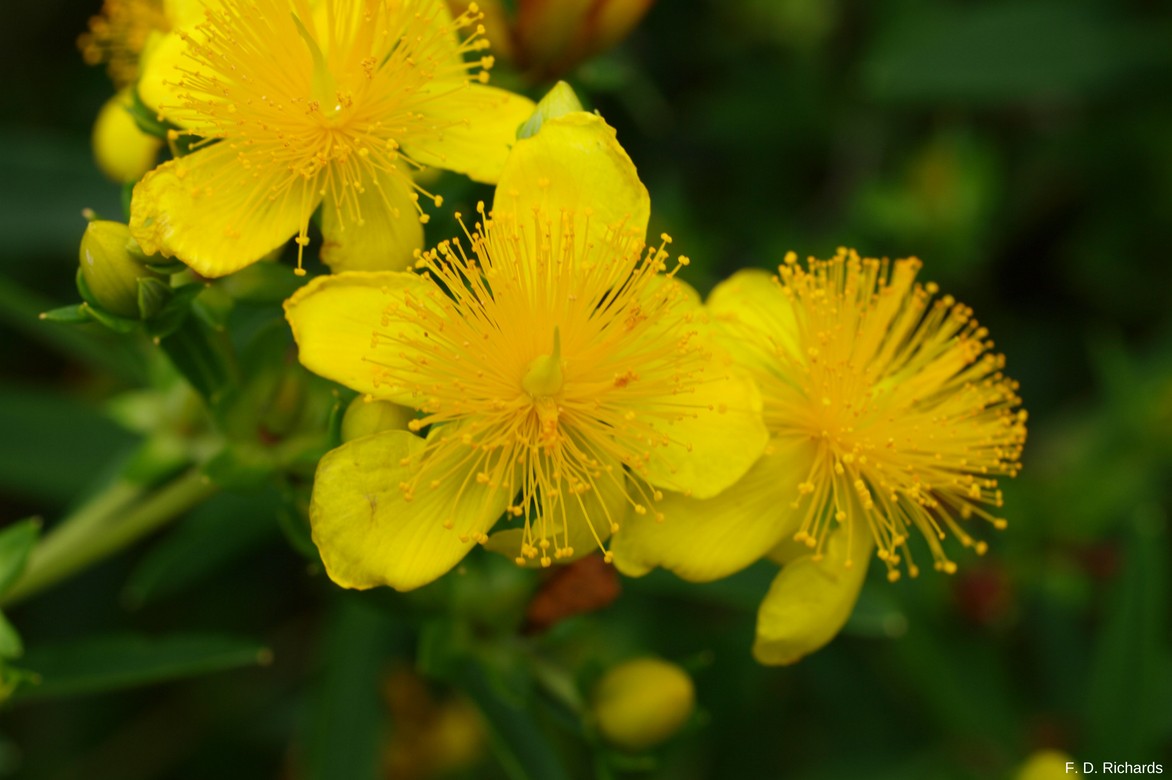
Beautiful bright flowers of Hypericum kalmianum ‘Gemo’.
The Odourless St. John’s Wort (Hypericum inodorum) reveals a whole different interest in its richly coloured fleshy fruits. Set in their bright green persistent sepal casing, the fruits display various shades of pink, red, orange, purple, or white alongside the delicate flowering that remains with these corymbs of lemon yellow to golden yellow flowers. The berries thus extend the appeal of this semi-bush until the end of autumn. The branches adorned with clusters of fruits can be used in the composition of very original country-style bouquets.
Among the different species of Hypericum, you will also discover a whole range of leaf shapes and colours ranging from purplish washed greens in Hypericum androsaemum ‘Albury Purple’, to cream, green, and pink variegated forms in Hypericum moserianum Tricolor, to blue-grey in H.kalmianum Blue Velvet, but also intense greens in kalmianum ‘Gemo’.
This foolproof plant, useful in rockeries, border beds, on slopes, is also appreciated for the duration of its flowering stretching from June to September, its hardiness, its rapid growth, and its robustness. St. John’s Worts adapt to all types of well-drained soils, even poor, calcareous, and dry, and thrive in full sun, partial shade, or even shade, although they flower less.
Description and Botany
Botanical data
- Latin name Hypericum sp.
- Family Hypericaceae
- Common name St. John's Wort
- Flowering between June-July and September-October
- Height between 15 cm and 1.50 m
- Sun exposure sun to shade depending on cultivars
- Soil type drained, moist to dry, fertile to mediocre depending on species
- Hardiness Very good most often
The genus Hypericum comprises around 400 species of annual, perennial, shrubby plants, and even a few small trees like H. lanceolatum reaching 10 m in height. They can be found all over the globe, except in deserts and arctic regions due to differentiation in the Cretaceous period before the continents separated. However, they are confined to open environments in temperate or warm zones and tropical highlands. The genus belongs to the family Hypericaceae according to the APG III phylogenetic classification, previously classified under Clusiaceae.
The term St. John’s Wort means “a thousand holes” – ‘wort’ referring to a hole or passage in Old French. When observing a leaf of the wild herbaceous species Hypericum perforatum, it appears that the lamina is pierced with small holes, which are actually glands filled with essential oil. The scientific name Hypericum, already present in Pliny the Elder’s writings, refers to something else, comparing the shape of the leaves to that of heather, from the Greek hupo meaning “almost,” and ériké meaning “heather.” Some species, such as H. olympicum, indeed exhibit this fine opposite foliage reminiscent of heather, but this explanation remains contested. Others claim that the etymology derives from huper and eikon, meaning “above,” “image, presentation.” Hippocrates and Paracelsus mentioned the healing virtues of St. John’s Wort, which was used to drive away demons, likely referring to its recently recognised anti-depressant effects, considered preferable to Prozac®.
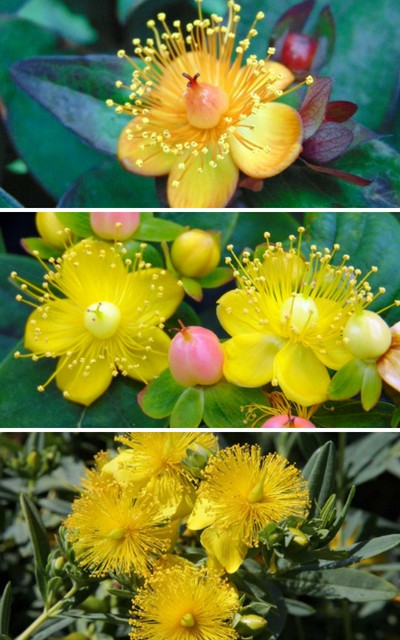
Flowers of Hypericum: ‘Magical Universe’, ‘Magical Beauty’ and ‘Blue Velvet’
The leaves have a rather graphic appearance due to their opposite arrangement, creating a sort of step-like pattern along the stems, and sometimes whorled. The lamina varies in width, being ovate to lanceolate, triangular in x inodorum, and without petiole. Hypericum x moserianum ‘Tricolor’ features dark green foliage variegated with cream white, pink, and light red. H. androsaemum ‘Albury Purple’ offers lovely green and purple hues dotted with small orange flowers associated with red fruits resembling pearls. H. frondosum ‘Sunburst’ is notable for its glaucous foliage. The foliage of cultivated varieties is often semi-evergreen, allowing enjoyment for a good part of the year and showcasing a range of autumnal hues in certain varieties like H. reptans, which is completely deciduous, turning red in autumn.
The flowers, particularly melliferous, are easily recognised by their yellow to orange cup-shaped corollas, adorned with a tuft of prominent stamens, mixed with 3 or 5 styles. Equipped with 5 persistent sepals and 5 petals, they measure 1 to 6 cm in diameter and are found solitary or most often grouped in cymes at the tips of the branches. They renew themselves over long months between May and October depending on the variety.
The fleshy fruits, sometimes dry in the form of capsules, spherical or oval stand above the persistent calyx, like a gemstone set in its case. They form simultaneously with new flowers blooming, so the foliage sparkles with a thousand lights, particularly in the species androsaemum and x inodorum. Their yellow, orange, red, or white hues (Hypericum x inodorum ‘Kolmawhi’ MAGICAL WHITE) eventually turn black, offering a bicoloured appearance for several weeks. These berries are appreciated by birds, which help in seed dispersal.
St. John’s Worts possess a rhizomatous root system that allows them to spread easily, especially in dwarf varieties. H. calycinum penetrates deeply into the soil, explaining its drought resistance.

St. John’s Worts have very decorative foliage: Hypericum moserianum ‘Tricolor’, Hypericum inodorum ‘Rheingold’, Hypericum ‘Golden Beacon’
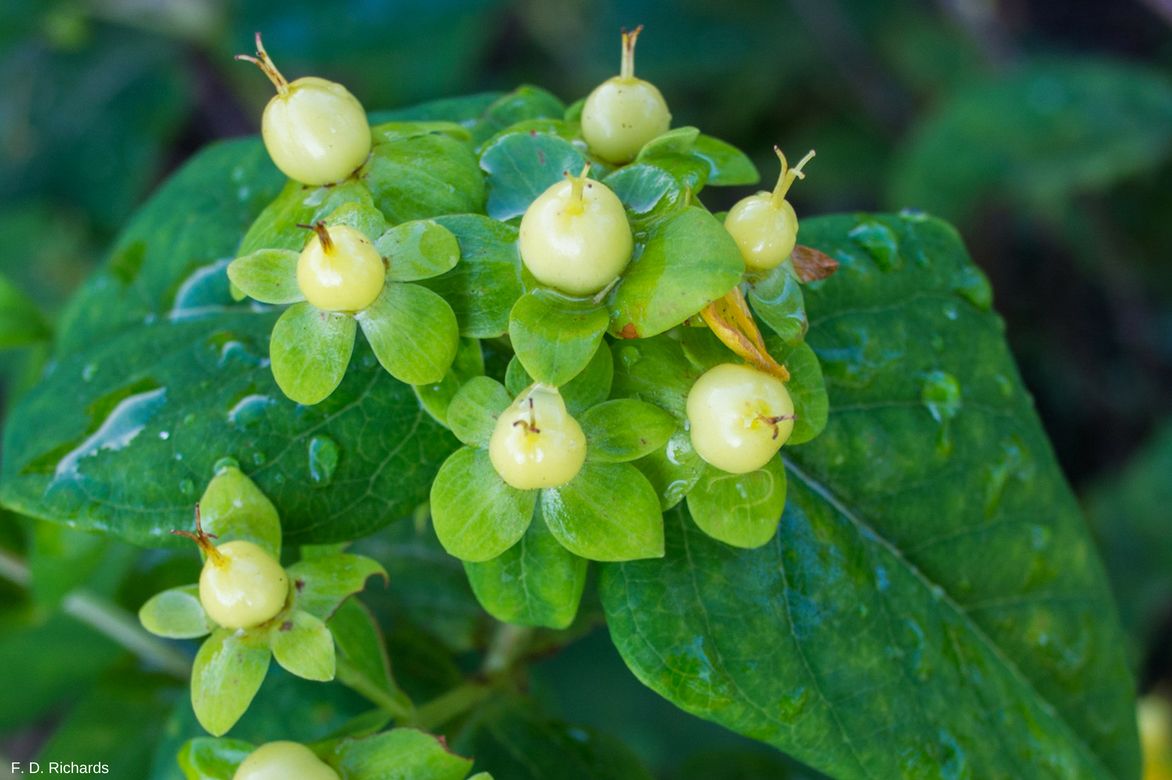
The berries of St. John’s Wort are the icing on the cake: Hypericum inodorum ‘Magical White’ (‘Kolmawhi’)
The main varieties
Si the Hypericum ‘Hidcote’ may seem outdated with its large golden yellow flowers borne by a dark glaucous green foliage, the various varieties of the odourless St. John’s wort offer a range of more subtle and innovative plants. They are the result of natural hybridization between androsaemum and hircinum. They form a clump 80 cm to 1.20 m more or less spreading, with fairly thin stems that sometimes disappear during harsh winters only to re-emerge in spring. Mild winters spare not only the stems but also the foliage, which is then best cut back by two-thirds to benefit from well-coloured shoots of pink, chartreuse green, or purple.
The flowering is much more delicate than that of Hypericum calycinum or ‘Hidcote’, bearing at the end of each stem corymbs that sometimes contain more than 20 small flowers measuring 1.5 to 3 cm in diameter. Their colours range from lemon yellow as seen in Golden Beacon, Magical Sunshine, to warmer tones, golden yellow in Magical Red to orange in Magical Universe. Small fleshy fruits richly coloured in yellow, red, orange, pink, purple, or cream, turning black, appear throughout the flowering period, starting in May and continuing well after, inserted in the casing formed by the persistent purple-green sepals. The berries thus extend the appeal of this semi-shrubby plant until the end of autumn. Magical Passion offers a sparkle of small red and black balls above a wide dark green foliage. The branches adorned with clusters of fruits presented in a bright green casing can be included in the composition of original bouquets.
The foliage of the odourless St. John’s worts is equally remarkable; its parent, the common androsème (H. androsaemum), has passed on its broad triangular green foliage, either marginate or washed with purplish red. Golden Beacon® displays light green shades at bud burst, golden yellow throughout the summer, finishing with orange-yellow in autumn like a “sunset”.
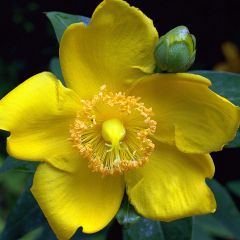
Hypericum Hidcote
- Flowering time July to November
- Height at maturity 1,50 m
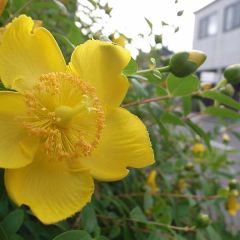
Hypericum calycinum - St. John's wort
- Flowering time July to October
- Height at maturity 35 cm
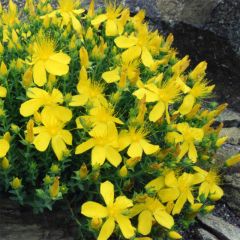
Hypericum olympicum - St. John's wort
- Flowering time June to August
- Height at maturity 35 cm

Hypericum kalmianum Gemo - St. John's wort
- Flowering time August to October
- Height at maturity 80 cm
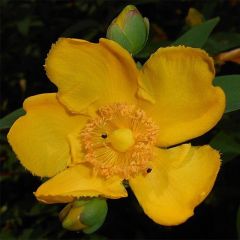
Hypericum x moserianum - St. John's wort
- Flowering time July to November
- Height at maturity 50 cm
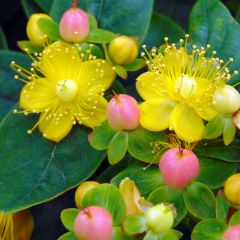
Hypericum inodorum Magical Beauty Kolmbeau
- Flowering time July to October
- Height at maturity 90 cm
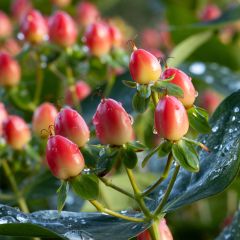
Hypericum inodorum Magical Red Flame KOLMAREF - St. John's wort
- Flowering time August to October
- Height at maturity 90 cm

Hypericum inodorum Rheingold - St. John's wort
- Flowering time June to September
- Height at maturity 1 m
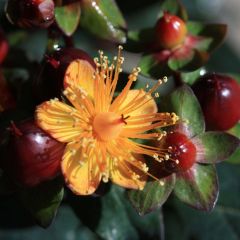
Hypericum x inodorum Magical Universe Kolmuni - St. John's wort
- Flowering time August to November
- Height at maturity 80 cm
→ To choose your variety well, follow our advice: “St. John’s wort, Hypericum: which variety to choose?“
Discover other Hypericum - St.John's Wort
View all →Available in 0 sizes
Available in 1 sizes
Available in 1 sizes
Available in 1 sizes
Available in 1 sizes
Available in 3 sizes
Available in 1 sizes
Available in 2 sizes
Available in 1 sizes
Available in 3 sizes
Planting St John's Wort
Where to plant Hypericum?
Hypericum thrive with little care and will not suffer from neglect, absence, or the mistakes of novice gardeners. Exposed to full sun, wind, and sea spray, and cold – all tolerate frosts down to -15°C – they bloom, time and again… They can be grown in pots, on terraces or balconies, regardless of the exposure. St. John’s worts truly deserve a place in all green spaces, on slopes, even in poor soil.
You can create a ground cover in sunny, semi-shaded, or even shaded situations if you are not necessarily looking for flowering with stoloniferous species such as calycinum, reptans, moserianum. Golden forms like Golden Beacon® will, however, look prettier in partial shade and will additionally provide a lovely touch of brightness. The plant can cover an area fully or fill spaces between bushes or perennials without causing too much competition. The species calycinum, androsaemum, and ‘Hidcote’ tolerate shade well, which means less than 4 hours of sunlight per day.
Shrubby subjects can be planted alone if their height reaches 0.8 to 1 m, such as H. ‘Hidcote’ or frondosum ‘Sunburst’. Less vigorous plants like ‘Gemo’, x inodorum, or moserianum ‘Tricolor’ are better appreciated in a perennial bed, a rockery, or in a large container.
The compact rounded clumps of Hypericum olympicum ‘Citrinum’, with large lemon-yellow flowers borne at the tips of fine grey-green stems, are well-suited for dry rockeries or to form borders. It blooms from May to July.
When to plant?
Although it is possible to plant St. John’s worts in pots at any time of the year, ideally, it is best to do so from October until March or April. Avoid intervening during frost, extreme heat, or when they are flowering.
How to plant?
Ground cover species like calycinum
- Weed the area and then work the soil with a fork to aerate it to at least 20 cm deep.
- Add a few shovelfuls of compost or organic fertiliser.
- Moisten the clumps of your plants in a bucket of water, then create holes spaced 30 cm apart to fill the space quickly.
- Place the collar level with the soil, then backfill the hole, pressing well around the plant. The plant should not pull out when you tug on it.
Shrubby species
Allow 40 to 60 cm around each plant to enable them to grow harmoniously. To create a hedge, I recommend spacing vigorous plants 0.80 to 1 m apart.
- Moisten the root ball to facilitate establishment.
- Replace the soil and lightly firm it down.
- Water generously.
- Spread a layer of mulch at the base to maintain good moisture around the roots. This will also limit the growth of weeds.
For pot cultivation, place a drainage layer of 3-4 cm at the bottom of the pot (gravel, broken pottery, etc.). Add a mix consisting of 1/3 soil, 1/3 potting compost, and 1/3 coarse sand.
Maintenance and pruning
St John’s Wort is an easy bush that requires virtually no maintenance.
Water in the first year to ensure establishment. Apply a complete fertiliser in the following spring after cutting back the dried foliage. Potted plants require more regular watering but will stop flowering if there is a water shortage.
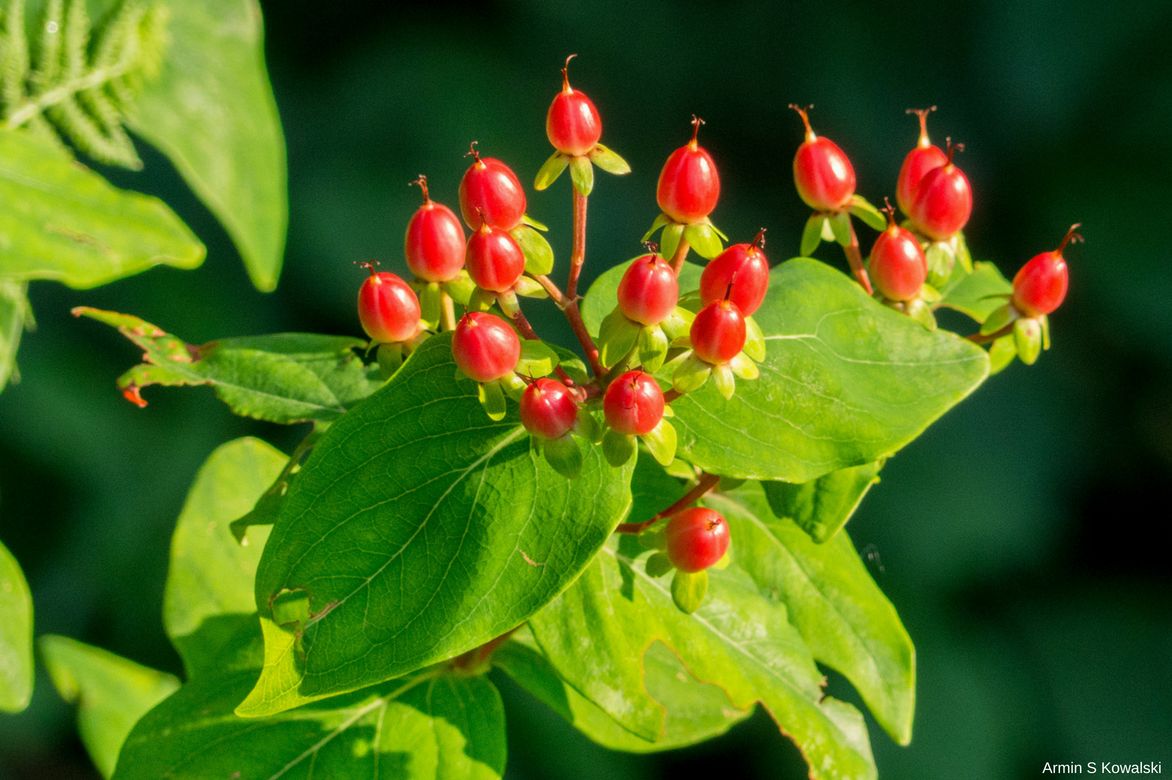
Decorative berries of St John’s Wort
Pruning St John’s Wort
Dwarf ground covers (5 to 20 cm) or low (30 to 50 cm)
(H. reptans, calycinum, x moserianum ‘Tricolor’)
This pruning is not obligatory but helps rejuvenate the plant, limit its spread by cutting back the runners, and maintain good density.
- Use the hedge trimmer or shear once a year. Operate in late flowering in autumn with evergreen species or in early spring with deciduous species.
Shrubby species:
- Remove dead branches and those that extend beyond the silhouette.
- Practice thinning pruning with pruning shears from time to time to aerate the centre of the bush by cutting back every other branch by half.
- The following year, you will prune the other half of the older branches.
- It is also possible to cut back the bush entirely approximately every 5 years.
Possible diseases and pests
St John’s Worts sometimes show orange pustules on the underside of the leaves. This is rust, a fungus that mainly affects forms derived from the hybrid Hypericum x inodorum (H. androsaemum X H. hircinum, found in nature on the Island of Madeira). Classic St John’s Worts are not very sensitive, and there are a number of resistant cultivars such as ‘Gemo’, x inodorum MAGICAL BEAUTY…
Avoid confining the plant in a damp location, aerate the branches, and prevent alternating between wet and dry soil to limit disease. Collect your pruning waste.
Multiplication: propagation by cuttings, sowing, division
You can propagate St John’s Wort by sowing and propagation by cuttings. Propagation by cuttings seems to be the best technique, as it is simple and will yield young plants more quickly, ensuring that they will be identical to the original variety. It is also possible to separate the runners of the running St John’s Wort.
Propagation by Cuttings
Cut St John’s Wort stems during the summer and up until early autumn.
- Prepare a pot by filling it with potting mix mixed with sand, or take your cuttings directly in the ground if it is light, after aerating it with a fork, then moisten the medium.
- Take cuttings about ten centimetres long from this year’s shoots by cutting horizontally just below a node. They should be healthy and free from diseases.
- Remove the leaves near the base of the cutting, and trim the others to reduce the leaf surface area. Leave only a few leaves at the top if they have not fallen off.
- Make a hole in the medium using a pencil or a wooden stick.
- Place the cutting in the hole and gently firm the soil around it to eliminate air pockets and ensure good contact between the potting mix and the cutting.
- Place the pot under a frame in a warm, bright location but out of direct sunlight.
- Transplant the rooted cuttings in spring into a richer medium and grow them for at least until the following spring before placing the plants in their final location.
Sowing
Sowing St John’s Wort is done in autumn, but you cannot be sure of obtaining the selected variety from the start.
Harvest the seeds in autumn when the fruits have darkened and separate the seeds from the pulp. Rinse the seeds before storing or sowing them.
- Prepare a pot by filling it with special seed compost.
- Sow the seeds by burying them under 1 cm of soil and place them under a cold frame.
- Water with fine droplets.
Continue to water regularly, but without excess, to keep the medium moist. Repot the young seedlings a few months after germination. After one or two years, you can plant them in their final location.
Division and Layering
Carry out in autumn.
To divide a clump, separate the root ball with a sharp spade or cut with pruning shears a runner that has already developed roots to separate it from its mother plant.
For layering, bury a stem of a deciduous plant, previously notched, and bring it out a little further away. Wait at least one year before separating the layer from its mother plant.
→ Learn more in our tutorial: How to propagate St John’s Wort?
Usage and pairing
The flowering of St. John’s worts offers various shades of yellow ranging from lemon yellow to orange and golden yellow. Avoid mixing warm yellows (calycinum, ‘Hidcote’) with cool yellows, for example, those diffused by the foliage of x inodorum Golden Beacon or the flowers of olympicum ‘Citrinus’. These colours cancel each other out unless you add a touch of bluish grey or dark green, or stagger these colours over time. You can surround your beds of Hypericum with Euphorbias and Alchemillas, which have very flattering foliage and bloom in chartreuse yellow tones much earlier.
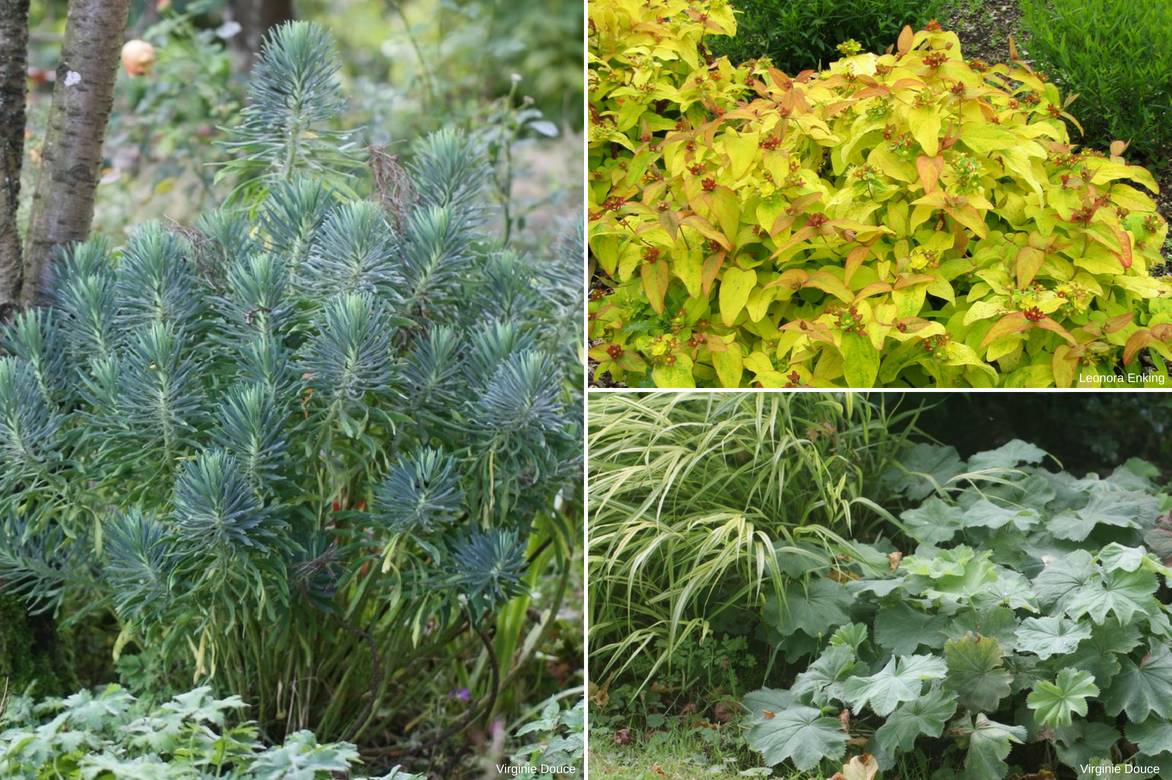
An idea for association: Hypericum ‘Golden Beacon’, Euphorbia characias ssp. wulfenii, Hakonechloa macra ‘Aureola’ and Alchemilla mollis
Golden yellow pairs well with plants of similar tones such as goldenrods (Solidago), loosestrifes, Kniphofia caulescens, the yarrow ‘Coronation Gold’, or Rudbeckia. Remember to vary the habits of the plants to achieve a harmonious ensemble. To soften the brightness of yellow, which can become tiresome, combine St. John’s wort with the blue-grey of a Caryopteris, a Perovskia, or a blue chaste tree (Vitex agnus-castus), or with the bronze of a purple fennel or Macleaya. The purple of a Physocarpus, Cotinus coggygria ‘Rubrifolia’, or a Berberis thunbergii ‘Admiration’ or a Phormium will create a trendy effect.
→ Discover more association ideas with St. John’s wort in our advice sheet.
To go further
- Discover our wide range of Hypericum: varieties for every situation
- Advice sheet: 10 bushes with summer flowering that you must have in your garden
- Discover our advice sheet on St. John’s Wort: herbal tea and benefits and St. John’s Wort: what are its health benefits?
- Subscribe!
- Contents
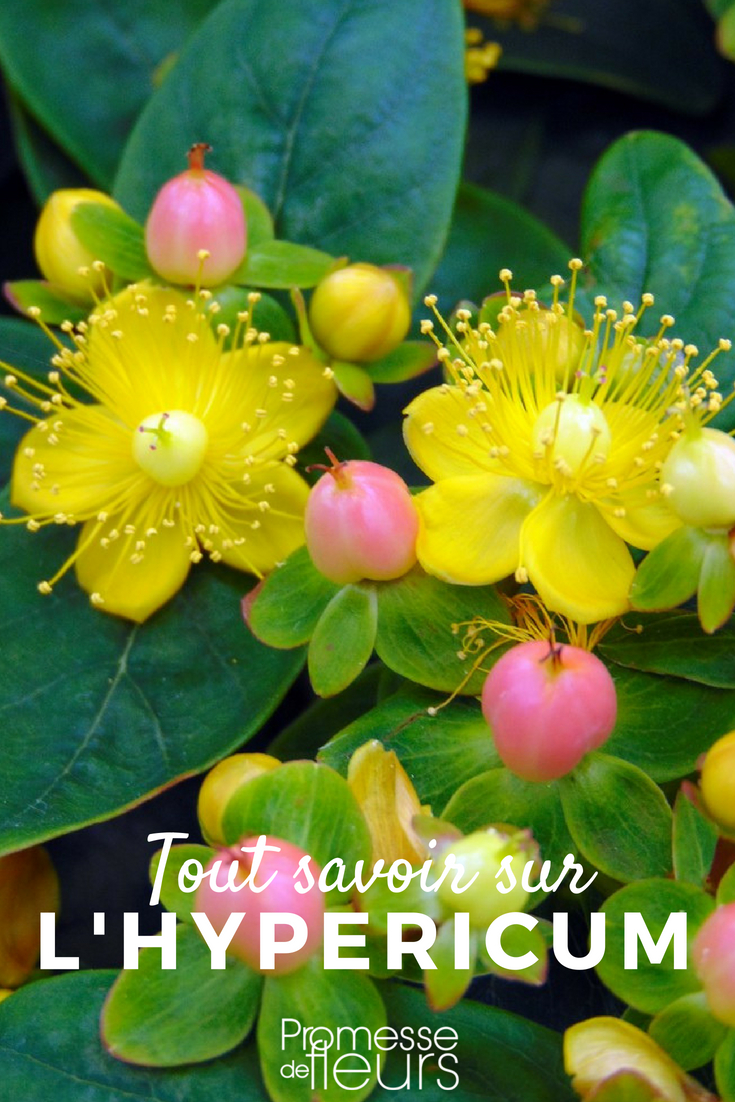































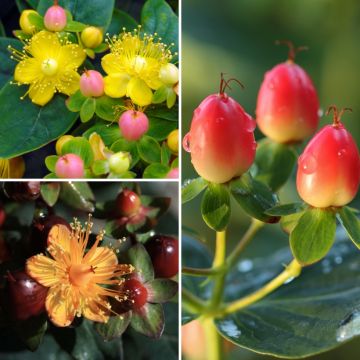
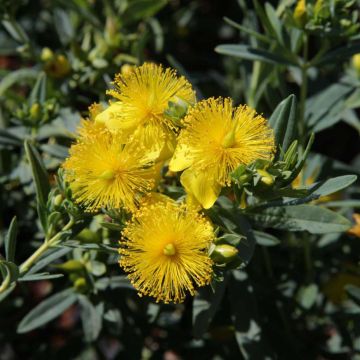


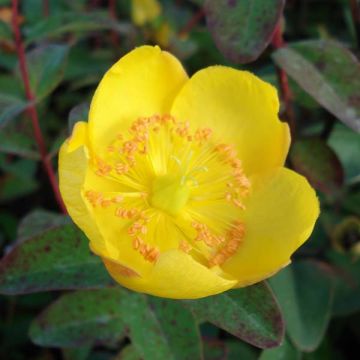



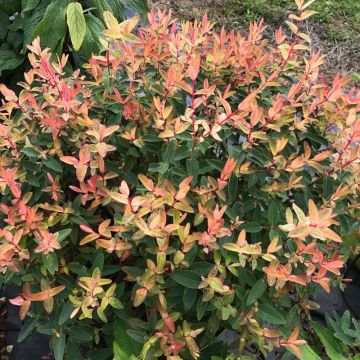

Comments